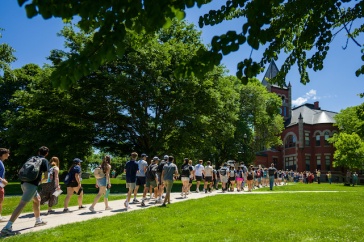
When the school year began earlier this month, the University of New Hampshire welcomed some 3,400 first-year students, more than 1,000 of whom enrolled in majors in the STEM science, technology, engineering or mathematics (STEM) disciplines. It’s the largest incoming STEM class in UNH history—and a significant step forward in the university's commitment to double the number of STEM students it graduates by 2025.
|
|
Katherine Hyson ’18 is one of those students. A prospective neuroscience major, She thinks she wants to go to medical school. If not, then she’ll be a researcher, with hopes of trying to unlock the sad mysteries of neurological diseases like Parkinson’s, which has stricken both her grandfathers.
Sean Horigan ’18 is another. Planning to major in civil engineering, he talks about the need to fix the country’s aging infrastructure—old bridges and highways that need replacing. He notes the last major infrastructure boom in America was after World War II. Today, estimates to make necessary repairs top more than $2 trillion.
 Sean Horigan '18 Sean Horigan '18 |
Ray Cook, an associate professor in the department of civil and environmental engineering, believes students like Hyson and, Horigan are what it’s going to take to tackle the challenges facing the world today. The importance of educating the next generation of STEM graduates is gigantic, he says.
“The world is stressed in so many ways,” Cook says. “Water resources are a big issue. The global population is rising dramatically. The world is finally convinced our climate is changing. Our bridges are old; water mains are breaking. As society continues to run into these problems, we’re going to have to look to STEM majors to fix them.”
A dual major in neuroscience and business administration, Chloe Schmir ’18 may well be one of those fixers. The Eliot, Maine, resident says she has always had a strong interest in science.
“I love how it explains the world around me and how I function,” she says. “STEM fields are important because they fuel the modern world. Everything around us involves at least one aspect of the STEM fields.”
A love of science—or math, or technology or engineering—is a key aspect of choosing a major, says Wayne Fagerberg, a professor in the department of molecular, cellular and biomedical sciences. “The reasons for studying STEM subjects are obvious. But students really need to love whatever it is they’re getting into,” Fagerberg says. “Their enthusiasm for the subject is what’s going to carry them through.”
And then there is the job factor. According to the U.S. Department of Labor’s Bureau of Statistics, as of May 2013, nearly 17 million people were employed in STEM occupations at an average salary of nearly $80,000. That’s a selling point as the university pushes forward on its commitment to double the New Hampshire STEM workforce, a pledge USNH undertook with the New Hampshire Community College System in 2012.
“There are definitely jobs out there,” Cook says. “Many of our students have jobs lined up when they graduate. It’s one of the things you think about when you go off to college: ‘Will I get a job afterward?’”
 Kevin Poulin '18 Kevin Poulin '18 |
Kevin Poulin ’18 is pretty certain he will. A civil engineering major, Poulin has been working for a local surveying and engineering company since he was 16 years old.
“I learned a lot and realized I’d developed a strong interest in this area so when it came time to choose a major, I knew what I wanted to do,” Poulin, of Middleton, says. “I like the idea of doing something knowing your expectations can be met—that you can see the results of your work. I think it’s a field where broad-based knowledge is required, and that challenges me.”
-
Written By:
Jody Record ’95 | Communications and Public Affairs | jody.record@unh.edu

















































